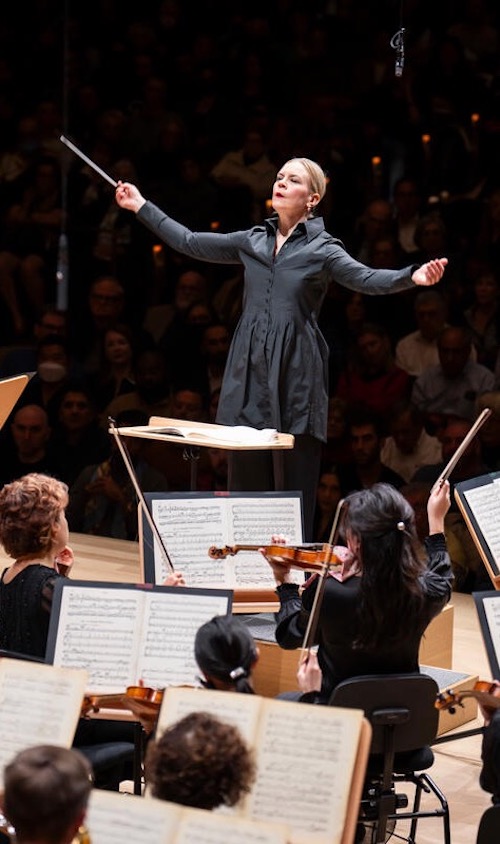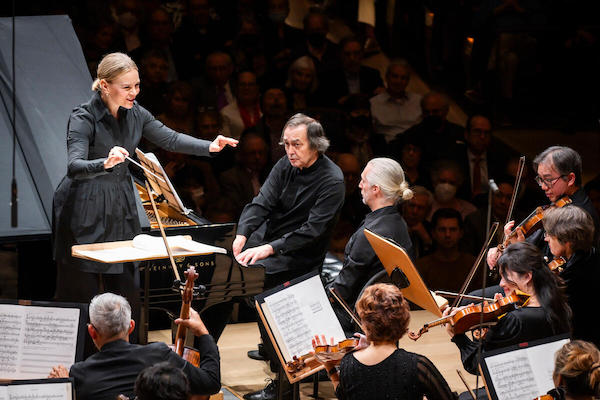Mälkki revitalizes old and new music in folk-infused Philharmonic program

This year is the centennial of György Ligeti. For such an occasion, and for so significant and well-known a composer, it is both bizarre and dispiriting that so little attention has been paid by New York City organizations.
The exception has been the New York Philharmonic, which has been remembering the composer and presenting his music as part of subscription programs through this season. For this week’s program that opened at David Geffen Hall Thursday night, that meant Ligeti’s Piano Concerto, with pianist Pierre-Laurent Aimard as soloist.
The concert was conducted by Susanna Mälkki and featured the Philharmonic debut of a musician playing a notable instrument. That was cimbalom player Jenō Lisztes, who opened the night with a solo performance of his arrangement of Liszt’s Hungarian Rhapsody No. 2. This was marvelous to hear on its own and was an integral prelude to an ingeniously designed program. The solo was followed by Bartók’s Romanian Folk Dances, the Ligeti concerto, and finished with Mussorgsky’s Pictures at an Exhibition—opening up the kind of world of sound that fits classical music into a broader and deeper context.
Start with the sound of the cimbalom, a hammered string instrument common to central European and Balkan folk music. It’s duophonic, so Lisztes’ arrangement meant slimming down Liszt’s harmonies, but the incredible overtones and the rhythmic punch of its clangy, sinewy sound more than made up for it. Liszte’s playing made it sound exactly like folk music, something for drinking and dancing and entertaining, and brought down the house.
It also prepared the flavor of the Romanian Folk Dances, in the 1917 orchestration. As much as he was a vital classical composer, so was Bartók a vernacular musician, not dissimilar to Gershwin but in a style that sounds exotic and abstract to many listeners. This night, it was easy to hear it as folk music that just happened to be played by an orchestra.
A surprise was that it took some time for the performance to get going. Mälkki is poised at the podium and her excellent baton technique always projects focus, but the playing was a bit too relaxed though the first few dances. They are slow to begin with, but needed a little firmer direction. But the energy picked up appreciably with concertmaster Frank Huang’s decisive and articulate solo in the “Horn Dance,” and the performance finished with drive.

Aimard has been playing Ligeti for decades—he recorded the Piano Concerto 30 years ago—and his sheer ability to play the demanding solo part can’t be overvalued. It was important to be able to hear Ligeti’s compositional ideas so clearly, especially the material that would be incorporated into his Etudes. Following the first two pieces, one heard the foundation in the earthy rhythms of folk music, and how Ligeti nudged them in different directions to make complex and exciting patterns. The composer also compressed phrases out of folk music into dense, extremely fast patterns, and Aimard tore through this, with Mälkki and the orchestra in absolute coordination.
Ligeti’s humor came through too, a key to a piece that moves back and forth between following traditional concerto manners and antagonizing them—pressing convention to the maximum in the opening moment then emptying it out in the slow, spare, delicate “Lento e deserto.” The longest section of the concerto, it’s a bare superstructure of haunting, drifting winds (including ocarinas) with occasional stabs from the piano. Though many in the crowd had difficulty concentrating, this was beautifully played, with a steady pulse that held in the silences, and an uncanny feeling.
From here, the concerto moves smoothly from mysterious to exciting, using velocity of notes to push and pull around time. Aimard was near-phenomenal in how he kept the music flowing even as the rhythmic accents and downbeats shifted underneath, the orchestra with him step by step. Just after the final note, he and Mälkki looked at each other with an expression that said, “We did it!”
The Philharmonic sounds different when this conductor is in the house—somehow more vivid, bigger. Those qualities delivered a tremendous performance of Pictures.
If one attends orchestra concerts with any regularity, one becomes more than accustomed to this work (in Ravel’s familiar orchestration), so that it is enjoyable but rarely out of the ordinary.
This was no ordinary performance. In no way idiosyncratic, it was the playing that was so fine throughout, along with the pace and shaping from Mälkki. Starting with Chris Martin’s brilliant, mellifluous trumpet fanfare, the instrumental sounds were gorgeous and refined. The woodwinds as a section were simply luscious throughout, and the low brass produced a huge and nuanced body of sound in the “Catacombae.”
Most of all, this was a performance of an overly familiar work that was full of the kind of purposeful, meaningful drama one rarely hears in this piece anymore. One wanted to hear it again and again.
This program will be repeated 2 p.m. Friday and 8 p.m. Saturday. Pierre-Laurent Aimard plays a Nightcap show with pianist Joachim Kühn, 10:30 p.m. Saturday, and then plays a solo recital of Ligeti, Beethoven, Chopin, and Debussy, 7:30 p.m., November 7. nyphil.org